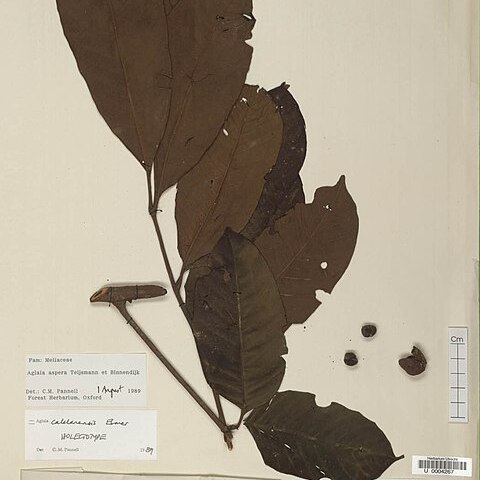Tree up to 29 m with ascending branches and a rounded crown. Bole up to 12 m, up to 40 cm in diam., sometimes with L-shaped buttresses upwards up to 1.8 m, outwards up to 2 m and up to 20 cm thick. Bark smooth, greyish-brown, yellowish-brown or reddish-brown with grey, green and pale brown patches, inner bark pink or brown; sap-wood yellowish-brown, orange, pinkish-yellow or reddish-brown; latex white. Twigs slender, densely covered with reddish-brown stellate scales. Leaves imparipinnate, up to 72(–100) cm long and 50(–75) cm wide; petiole up to 17 cm, petiole, rachis and peti– olules with indumentum like the twigs. Leaflets 7–13(–17), 7–22(–45) by 1.5–8.5(–15) cm, dark green above and silvery–green or brownish–green below when dry, acuminate at apex, rounded, subcordate or cuneate at the asymmetrical base, with a few stellate scales and numerous pits on the upper leaflet surface and with numerous to densely covered with scales like those on the twigs or peltate scales with a long fimbriate margin on the midrib below, numerous on the rest of the lower surface, interspersed with brown stellate hairs which have many short arms; veins 7–14(–29) on each side of the midrib; petiolules up to 12(–35) mm. Male inflorescence up to 40 cm long and 40(–50) cm wide with indumentum like the twigs; peduncle c. 5 mm. Flowers up to 1.5 mm in diam.; pedicels 1–2 mm long. Calyx with numerous stellate scales on the outside. Petals 5. Staminal tube 0.5–1 mm, either shallowly cup–shaped with the apical margin incurved and shallowly 5–lobed or ovoid and with the aperture less than 1 mm in diam.; anthers 5, about half to longer than the length of the tube, inserted near the base or just below the margin of the tube and protruding through the aperture, pointing towards the centre of the flower. Female inflorescence little branched, up to 30 cm long and 30 cm wide. Flowers similar to the male but slightly larger. Infructescence c. 20 cm long. Fruits sub– globose or obovoid, up to 5 cm long and 4 cm in diam., yellow, reddishbrown or orange– brown, the pericarp up to 2 mm thick, hard and brittle or woody, densely covered with reddish-brown stellate hairs or scales on the outside, sometimes containing white latex. Locules 2, each containing 1 seed. Seed with a complete transparent or white aril.
More
A tree. It grows 29 m tall. The branches point upwards. The bark is smooth and greyish brown with pale patches. The leaves are 70-100 cm long and 50 cm wide. It has leaflets along the stalk. Plants are separately male and female. The flowers are 1.5 mm across and cup shaped. The fruit are a flattened round shape and 5 cm long by 4 cm wide. The seeds have a white layer around them.


